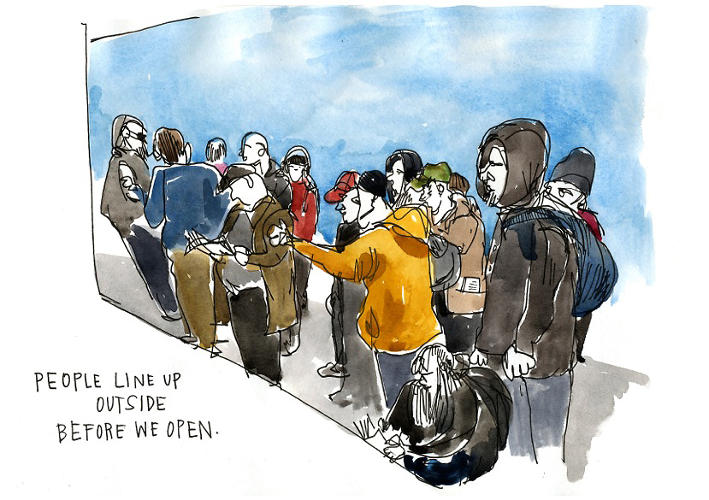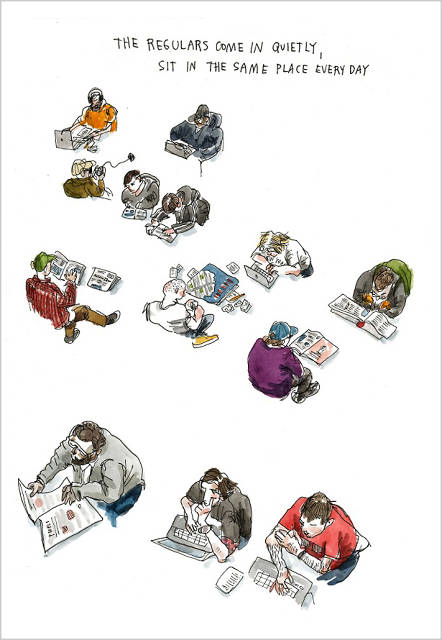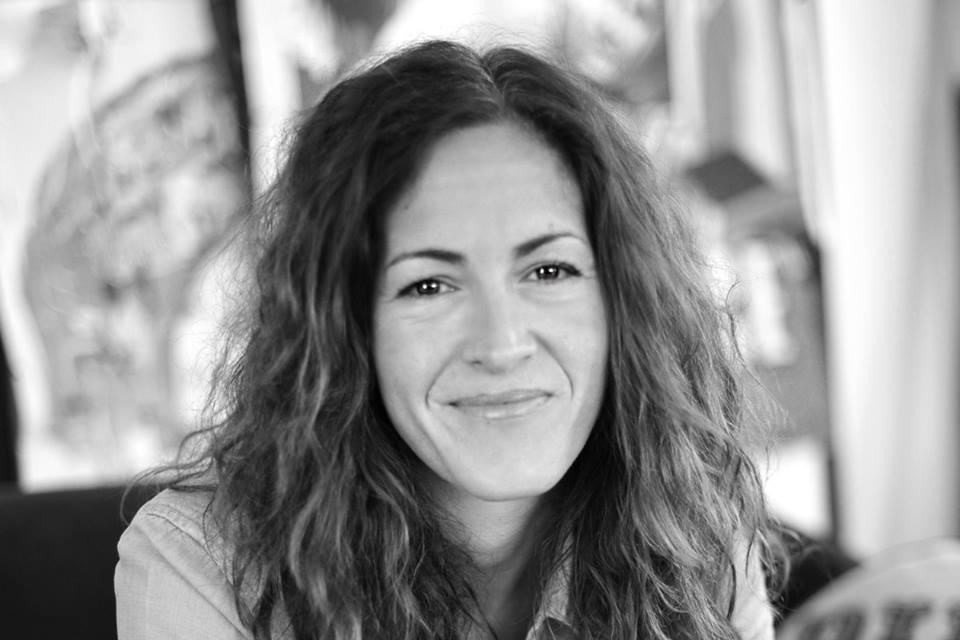Wendy MacNaughton believes illustration is a vehicle to tell stories. In her illustrated documentaries, she focuses on people and communities whose stories don’t usually get told, who are not in the spotlight – people living on the streets, public library workers and readers, people at the farmer’s market. For her wonderful and witty stories, she spends months hanging out with her subjects, getting to know them and trying to put herself in their shoes, all while sketching them. She then uses their words and her drawings – a combination of pen ink drawing and watercolor paintings – to create an illustrated narrative.
 Illustration by Wendy MacNaughtion, republished with the author’s permission.
Illustration by Wendy MacNaughtion, republished with the author’s permission.
She loved drawing and painting ever since she was a kid, so she studied at the Art Center College of Design in Pasadena, California. But after a few months in school, she gave up drawing and focused more on contemporary art, doing performance videos and sculpture installations, because at that time, that was the big thing, as she said in this Longform podcast interview. She didn’t draw or paint for the next ten years, during which she worked in advertising, studied social work and designed humanitarian campaigns in Africa.
One day, while she was back in San Francisco doing advertising for nonprofits, she noticed during her daily commute how all the people on the subway were standing still, just like the models she used to draw back in the day. So she started sketching them, as she recounts in the same interview. Every day, 20 minutes each way, five days a week. When she would get home at the end of each day, she would paint them, scan them and put them on a blog. The blog became quite visible and somebody offered to buy some drawings. Wendy says that even though she went to art school, it never really sunk in that she could draw and be paid for that. And that it could be her living.

Illustration by Wendy MacNaughtion, republished with the author’s permission.
Since then, her work has appeared in publications like the New York Times, Wall Street Journal, and Print Magazine, and she published several books: Meanwhile in San Francisco, The City in Its Own Words; Lost Cat: A True Story of Love, Desperation, and GPS Technology; Pen & Ink, Tattoos and The Stories Behind Them; and The Essential Scratch and Sniff Guide to Becoming A Wine Expert.
Here are some of the things Wendy learned about creative life throughout the years:
1. “We get away with a lot of stuff when we’re younger and we don’t have that fear and we believe we have nothing to lose.” In this Longform interview, Wendy talks about to the time she spent workeing Africa, doing communications campaigns for local elections and health education. She was only 22 and, because she had experience in advertising and knew how to draw, was asked to work on the first democratic elections in Rwanda. She created a campaign that was totally drawn, as to be understood by people who couldn’t read, and it resulted in a high voter turnout. It was her first project with real social impact, and that made her realize she could use her skills to create something that really makes a positive impact in people lives.
2. “All of us freelancers might have at some point taken on side projects that we do, that we’re very good at, that pays well, but we might not tell everybody about it, it’s not something we’d put on the top of our resume.” Wendy designed, for example, packaging for chicken salad and sandwiches – which were healthy and hormone free, she adds in the same interview. “I think everybody freelancing has the chicken salad on the side.”
3. “If you learn to listen to what people are telling you, it’s so much better then what you can imagine.” In this interview from the Compostmodern conference, Wendy talks about the process behind her work and how she often goes into a story thinking she knows what it’s going to be about, but within few days realizes it’s something completely different, for the better.
4. “Empathy is critical, and when you look at someone through an empathic lens, there’s a huge story there. It’s never just what you see on the surface. Life is a lot more interesting through other people’s eyes than through mine.” In this interview, Wendy talks about how she gets inspiration from just looking at things, like how a line forms at a coffee shop, or the weird ways that women tie sweaters around their necks. All these details have amazing stories behind them, if we pay attention.
Book your place at the 5th edition of The Power of Storytelling to meet Wendy and learn more about her work.
